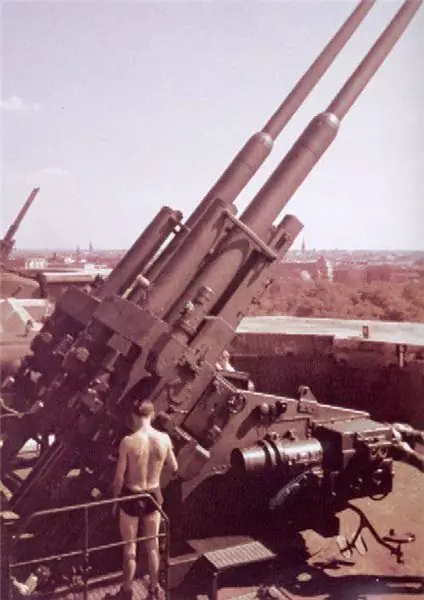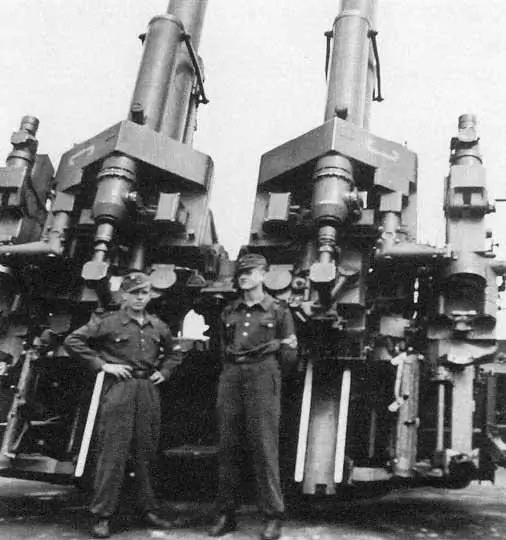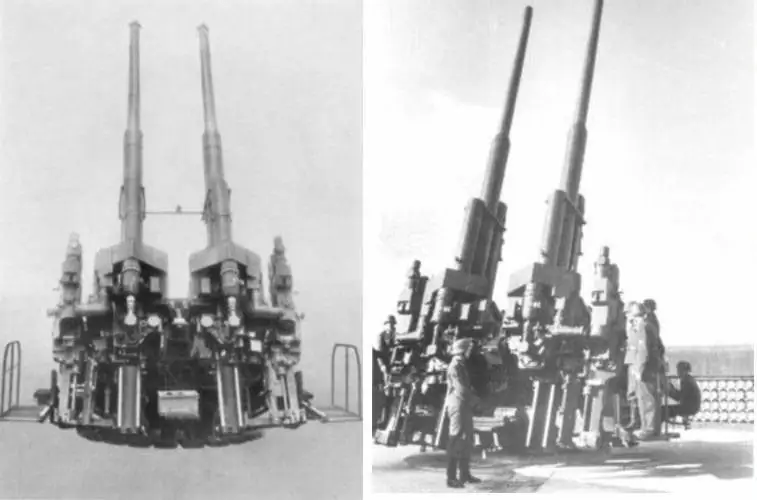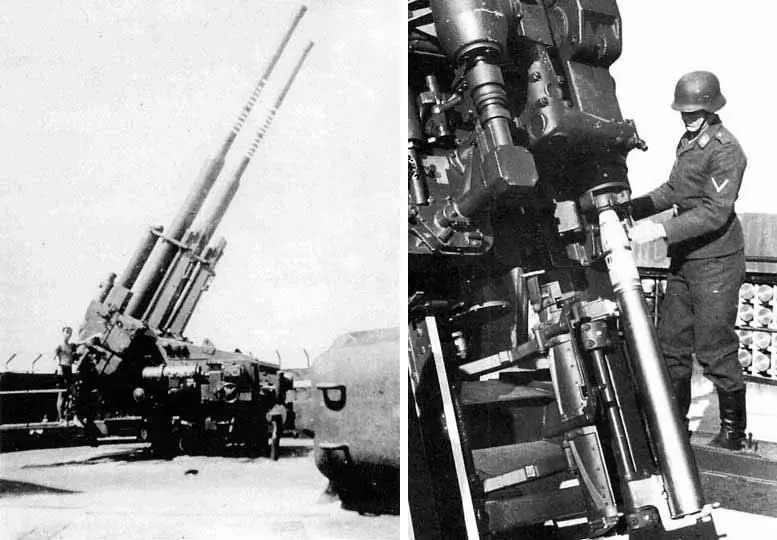- Author Matthew Elmers [email protected].
- Public 2023-12-16 21:49.
- Last modified 2025-01-24 09:17.
In the 1930s and 1940s, the German military industry was one of the most developed in the world. The pace of military build-up was significant. But she had one unique property - gigantomania, which was reflected in the development of all types of weapons, including anti-aircraft weapons. To destroy air targets, new models of anti-aircraft artillery were designed. Despite the emergence of new large-caliber anti-aircraft guns -88-, 105- and 128-mm, the Germans continued to increase the reach in height and increase the power of the projectile. In 1938, prototypes of 150-mm guns were created, and in 1941, 240-mm guns! Despite the good possible characteristics, the developers were faced with some intractable problems, which mainly concerned the reliability of the loading system. Ultimately, the development of 240-mm anti-aircraft guns was stopped in October 1943.

In addition to the mechanical increase in caliber, German designers created multi-barreled large-caliber systems - an unheard-of thing until that time. It must be said that a similar idea has already surfaced somewhat in the design bureaus of German weapons manufacturers - back in the late 1920s. "double-barreled guns" were developed, with barrels of 37 and 75 millimeters, capable of effectively fighting enemy manpower and tanks. In other countries, similar work was also carried out. Such "universal" artillery systems remained in single copies, but during the Second World War, this principle was reborn. By the end of 1941, the German air defense, to fight against Anglo-American bombers flying at high altitudes, received the aforementioned 128-mm cannons, capable of destroying enemy aircraft at altitudes up to 14800 m (up to 12800 m - with a remote fuse). These guns were the heaviest anti-aircraft guns that were used in combat conditions.
The idea of producing 128-mm guns arose back in 1936; a corresponding offer was made to Rheinmetall. In 1940, a prototype of the gun appeared, and at the same time it was decided to give it to the active army. Despite the impressive weight and size of the gun, the first 6 128mm FlaK 40s were mounted on self-propelled chassis. However, the gun was so massive that it was transported without disassembly for a short distance, and for long-distance transportation it was disassembled into two cargo places, however, this was also difficult. In this regard, subsequent samples were produced exclusively for stationary installation in well-fortified points. In some places, specials were built. air defense towers. Production of a model for a stationary installation began in 1942, but it was so expensive and complex that by January 1945 there were only 570 units in service.

However, the air defense command considered the power of even these guns insufficient. Therefore, to increase the density of anti-aircraft fire based on the 12.8 cm Flak 40, a twin anti-aircraft gun 12.8 cm FlaK 42 Zwilling ("Gemini") was developed. Since 1942, it has been produced by the Hanomag company and entered service with the air defense units of Berlin, Hamburg and Vienna. Structurally, FlaK 42 Zwilling consisted of two barrels of 128 mm Flak-40 cannons mounted on a single gun carriage with a common guidance system. Each barrel had its own device for installing a fuse, as well as an independent electrically driven charging system, due to which a total rate of fire of 24-28 rounds per minute was achieved. When creating a 128-mm two-gun stationary installation, a base from a 150 mm Flak Gerat 50 was used.
As a rule, these installations were located at stationary positions - reinforced concrete towers - by battery. The battery consisted of four twin cannons. Thus, the battery per minute could fire 96-112 shells weighing 26 kg to an altitude of 14800 meters. Considering that the radius of destruction of high-explosive fragmentation projectiles 12, 8 cm Sprgr. L / 5, 5m was 100 m, then one battery could inflict significant damage to enemy aircraft. The maximum horizontal range of a shot is 20900 meters.

The first four-gun battery was installed in the spring of 1942 in Berlin (according to other sources, in August of the same year). In service in August 1944, there were 27 installations, and in February of the following year - 34. Manufacturing of installations was carried out in Hanover at the plant of the company "Hanomag". At the beginning of 1944, one unit was produced per month, and at the end of the year - 12.
Although German air defense units armed with 88-128 mm anti-aircraft guns could not prevent the destruction of German cities by Allied aircraft, they, according to German military experts, “had a much greater efficiency than is commonly believed. In 1943-1944. Allied bombers returned from missions with damage in every fourth vehicle. This meant that the Allies lost about 4,000 bombers a month. Aircraft repair was time consuming and difficult, and damage that was not discovered during the next flight led to the death of the aircraft.” Some German sources report that anti-aircraft artillery destroyed 38 percent of all Allied aircraft in the last three years of the war. Also interesting is the fact that during the defense of Germany, women and 16-18-year-olds were involved in servicing anti-aircraft installations 12, 8 cm FlaK 42 Zwilling. This was due to the lack of men for the full calculation of the gun - 22 people.

The performance characteristics of 12, 8-cm FlaK 42 Zwilling:
Caliber - 128 mm;
Overall length - 9230 mm;
Barrel length - 7835 mm;
Width - 4200 mm;
Height - 2950 mm;
Vertical guidance angle - from 0 to +87 degrees;
Horizontal angle of fire - 360 degrees;
Weight 32000 kg;
Rate of fire - 24-28 rounds per minute;
The greatest firing range - 20900 m;
Reach in height - 12800 m;
The initial velocity of the fragmentation projectile is 880 m / s;
The mass of the fragmentation projectile - 26 kg;
Calculation - 22 people.

Prepared based on materials:






